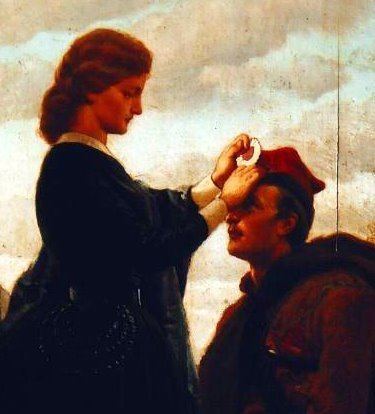 | ||
A cockade is a knot of ribbons, or other circular- or oval-shaped symbol of distinctive colors which is usually worn on a hat.
Contents
Eighteenth century
In the 18th and 19th centuries, coloured cockades were used in Europe to show the allegiance of their wearers to some political faction, their rank, or as part of a servant's livery. Military uniforms would use cockades as well.
A cockade was pinned on the side of a man's tricorne or cocked hat, or on his lapel. Women could also wear it on their hat or in their hair.
In pre-revolutionary France, the cockade of the Bourbon dynasty was all white. In the Kingdom of Great Britain supporters of a Jacobite restoration wore white cockades, while the recently established Hanoverian monarchy used a black cockade.
During the 1780 Gordon Riots in London the blue cockade became a symbol of anti-government feelings and was worn by most of the rioters.
During the American Revolution, the Continental Army initially wore cockades of various colors as an ad hoc form of rank insignia, as General George Washington wrote:
As the Continental Army has unfortunately no uniforms, and consequently many inconveniences must arise from not being able to distinguish the commissioned officers from the privates, it is desired that some badge of distinction be immediately provided; for instance that the field officers may have red or pink colored cockades in their hats, the captains yellow or buff, and the subalterns green.
Before long however, the Continental Army reverted to wearing the black cockade they inherited from the British. Later, when France became an ally of the United States, the Continental Army pinned the white cockade of the French Ancien Régime onto their old black cockade; the French reciprocally pinned the black cockade onto their white cockade, as a mark of the French-American alliance. The black-and-white cockade thus became known as the "Union Cockade".
In the Storming of the Bastille, Camille Desmoulins initially encouraged the revolutionary crowd to wear green; this colour was later rejected as it was associated with the reactionary Count of Artois. Instead revolutionaries would wear cockades with the traditional colours of the arms of Paris, red and blue. Later the Bourbon white was added to this cockade - thus producing the original Tricolore cockade. Later, distinctive colours and styles of cockade would indicate the wearer's faction—although the meanings of the various styles were not entirely consistent, and varied somewhat by region and period.
Cockades of the Confederate States
Echoing their use when Americans rebelled against Britain, cockades – usually made with blue ribbons and worn on clothing or hats – were widespread tokens of southern support for secession preceding the American Civil War of 1861–1865.
Cockades of the European military
From the 15th century various European monarchy realms used cockades to denote the nationalities of their military. Their origin reverts to the distinctive colored band or ribbon worn by late medieval armies or jousting knights on their arms or headgear to distinguish friend from foe in the field of battle. Ribbon-style cockades were worn later on helmets and brimmed hats or tricornes and bicornes just as the French did, and also on cocked hats and shakoes; metal cockades were worn at the right side of helmets; small button-type cockades were worn at the front of kepis and peaked caps.
During the Napoleonic wars, the armies of France and Russia, had the imperial French cockade or the larger cockade of St. George pinned on the front of their shakos.
The Second German Empire (1870–1918) used two cockades on each army headgear: one (black-white-red) for the empire; the other for one of the monarchies the empire was composed of, which had used their own colors long before. The only exceptions were the Kingdoms of Bavaria and Württemberg, having preserved the right to keep their own armed forces which were not integrated in the Imperial Army. Their only cockades were either white and blue (Bavaria) or black and yellow (Württemberg).
The Weimar Republic (1919–1933) removed these, as they might promote separatism which would lead to the dissolution of the German nation-state into regional countries again. In the Second World War, the Nazis, who hated the republican German colours black-red-gold used by the Weimar Republic, reintroduced the imperial colours (in German: die kaiserlichen Farben or Reichsfarben) of black on the outside, then white, and red on the inside were used on all army caps. These colours represented the biggest and the smallest countries of the Reich, Prussia (black and white) and the Hanseatic City States of Hamburg, Bremen and Lübeck (white and red).
France began the first Air Service in 1909 and soon picked the traditional French cockade as the first national emblem, now usually termed a roundel, on military aircraft. During World War I, other countries adopted national cockades and used these coloured emblems as roundels on their military aircraft. These designs often bear an additional central device or emblem to further identify national aircraft, those from the French navy bearing a black anchor within the French cockade.
Hungarian revolutionaries wore cockades during the Hungarian revolution of 1848 and during the 1956 revolution. Because of this, Hungarians traditionally wear cockades on 15 March.
List of national cockades
Below is a list of national cockades:
